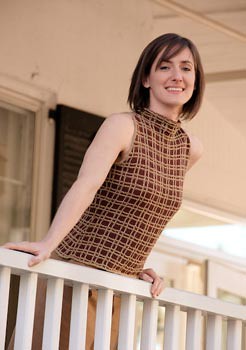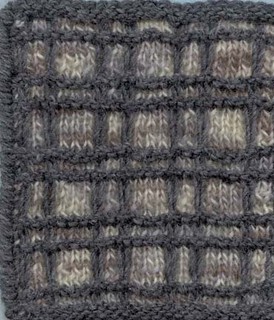 |
| Plaid knitting in a combination of techniques from Vogue Knitting Winter 2014/2015 design by Theresa Schabes |
One of my most popular classes is Mad for Plaid, where we cover several of the different techniques used by knitters to create the look of a woven plaid fabric. Generally, the methods by which to create a knitted plaid are:
- Slip Stitch
- Fair Isle/Stranded Knitting
- Intarsia
- one-stranded
- two-stranded
- Embellishment
- crochet chain
- duplicate stitch/Swiss darning
- knit-weave
- Plus combinations and a few odd-ball techniques
In class we are sometimes too busy knitting to view my slideshow covering examples of all the techniques, so I want to share it here. As well, I'll share my unsolicited opinions of the merits and drawbacks of each.
 |
| Fade to Gray by E.J. Slayton from Knitter's Magazine #93 |
Let's start with slip stitch plaids. Just as with regular slip stitch patterns, the plaid is created by regularly moving stitches from one needle to the other without knitting them. This is not a commonly used technique to achieve plaid for reasons I'll expand upon, but here are a few examples.
 |
| Plaid Halter by Gryphon Corpus from Interweave Knits, Summer 2008 |
 |
| Checked Cowl by Julie Weisenberger Pattern available from cocoknits |
 |
| Dhurrie by Lisa Richardson from Rowan Magazine #54 |
The advantages to slip stitch plaid knitting are that they are usually a strong graphic pattern, especially when strongly contrasting colors are used. They are also a relatively simple pattern work, since you never have more than one color in a row.
The biggest disadvantage to slip stitch plaids is that they are limited in scale. In the first two examples, the slipped stitches create the vertical lines of the plaid. If the plaid were larger, the floats would necessarily be longer. And, the longer the float, the more likely that the yarn will catch and snag as the garment is worn. The pattern can be scaled up by increasing the weight of the yarn used, such as in Dhurrie which is worked in an Aran yarn. However, in the photo you can see the puffiness of the plain tan boxes in contrast to the denser fabric of the mixed brown-and-tan slip stitch plaid boxes.
Within their limitations, I do like slip stitch plaids for smaller scale projects, such as accessories and kidswear. My first slip stitch plaid design is soon-to-be-published. (I'll keep you updated.)
Up next is stranded plaid knitting.


No comments:
Post a Comment